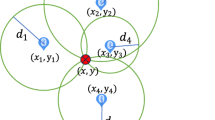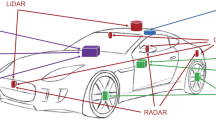Abstract
To improve localization accuracy, device-free passive localization studies usually deploy a number of sensor nodes in indoor environments, which causes redundant features and produces large data volumes and high deployment costs. This paper proposes the concept of a two-level redundancy and formulates the node reduction problem as a redundancy control problem. With the goal of using fewer nodes while maintaining high localization accuracy, a method is proposed to control the two-level redundancy efficiently and reduce the number of nodes greatly. Experiments are performed in two completely different environments. The proposed method is able to maintain accuracy levels above 90% and can efficiently reduce the total number of nodes by 59.09% in a large room (150 \({\mathrm{m}}^2\)) and by 68.75% in a small room (25 \({\mathrm{m}}^2\)). Furthermore, due to reduced nodes the proposed method can drastically reduce the needed amount of localization data and the hardware costs.




Similar content being viewed by others
References
Sigg S, Scholz M, Shi S, Ji Y, Beigl M (2014) Rf-sensing of activities from non-cooperative subjects in device-free recognition systems using ambient and local signals. IEEE Trans Mobile Comput 13:907–920. doi:10.1109/TMC.2013.28
Guo J, Zhang H, Sun Y, Bie R (2014) Square-root unscented kalman filtering-based localization and trackingin the internet of things. Pers Ubiquitous Comput 18:987–996. doi:10.1007/s00779-013-0713-8
Han C, Wu K, Wang Y, Ni LM (2014) Wifall: device-free fall detection by wireless networks. In: IEEE conference on computer communications (IEEE INFO-COM 2014), pp 271–279
Raja M, Sigg S (2016) Applicability of rf-based methods for emotion recognition: a survey. In: 2016 IEEE international conference on pervasive computing and communication workshops (PerCom workshops), pp 1–6
Wan J, OGrady MJ, OHare GMP (2015) Dynamic sensor event segmentation for real-time activity recognition in a smart home context. Pers Ubiquitous Comput 19:287–301. doi:10.1007/s00779-014-0824-x
Youssef M, Mah M, Agrawala A (2007) Challenges device-free passive localization for wireless environments. In: Proceedings of the 13th annual acm international conference on mobile computing and networking, MOBICOM 07, pp 222–229
Seifeldin M, Saeed A, Kosba AE, El-Keyi A, Youssef M (2013) Nuzzer: a large-scale device-free passive localization system for wireless environments. IEEE Trans Mobile Comput 12:1321–1334. doi:10.1109/TMC.2012.106
Liu J, An N, Hassan MT, Chen G, Zhang Y (2016) Poster abstract: node deployment mechanism for quick, indoor, and device-free localization. In: 2016 15th ACM/IEEE international conference on information processing in sensor networks, pp 1–2
Wilson J, Patwari N (2010) Radio tomographic imaging with wireless networks. IEEE Trans Mobile Computing 9:621–632. doi:10.1109/TMC.2009.174
Wilson J, Patwari N (2011) See-through walls: motion tracking using variance-based radio tomography networks. IEEE Trans Mobile Comput. doi:10.1109/TMC.2010.175
Sabek I, Youssef M, Vasilakos AV (2015) Ace: an accurate and efficient multi-entity device-free wlan localization system. IEEE Trans Mobile Comput 14:261–273. doi:10.1109/TMC.2014.2320265
Xu C, Firner B, Moore R, Zhang Y, Trappe W, Howard R, Zhang F, An N (2013) Indoor device-free multi-subject counting and localization using radio signal strength. In: Proceedings of the 2013 ACM/IEEE international conference on information processing in sensor networks (IPSN), pp 79–90
Abdel-Nasser H, Samir R, Sabek I, Youssef M (2013) Monophy: mono-stream-based device-free wlan localization via physical layer information. In: 2013 IEEE wireless communications and networking conference (WCNC), pp 4546–4551
Liu J, An N, Hassan MT, Xu C, Zhang Y (2017) An efficient node deployment method for indoor passive localization. Int J Ad Hoc Ubiquitous Comput (Accepted)
Yang J, Honavar V (1998) Feature subset selection using a genetic algorithm. In: Liu H, Motoda H (eds) Feature extraction, construction and selection. Springer, New York, pp 117–136
Abdi H (2010) Partial least squares regression and projection on latent structure regression (PLS regression). WIREs Comput Stat 2:97–106. doi:10.1002/wics.51
Zhang D, Ma J, Chen Q, Ni L (2007) An rf-based system for tracking transceiver-free objects. In: Proceedings of the fifth annual ieee international conference on pervasive computing and communications, 2007, Per-Com 07, pp 135–144
Zhang D, Liu Y, Ni L (2011) A real-time, accurate and scalable system for tracking transceiver-free objects. In Proceedings of the 2011 IEEE international conference on pervasive computing and communications (PerCom), pp 197–204
Xu C, Firner B, Zhang Y, Howard R (2015) The case for efficient and robust rf-based device-free localization. IEEE Trans Mobile Comput Early Access PP:1. doi:10.1109/TMC.2015.2493522
Kosba A, Saeed A, Youssef M (2012) Robust wlan device-free passive motion detection. In: Proceedings of the wireless communications and networking conference (WCNC), pp 3284–3289
Saeed A, Kosba AE, Youssef M (2014) Ichnaea: a low-overhead robust wlan device-free passive localization system. IEEE J Sel Top Signal Process 8:5–15. doi:10.1109/JSTSP.2013.2287480
Xu C, Firner B, Zhang Y, Howard R, Li J, Lin X (2012) Improving rf-based device-free passive localization in cluttered indoor environments through probabilistic classification methods. In: Proceedings of the 2012 ACM/IEEE 11th international conference on information processing in sensor networks (IPSN), pp 209–220
Wilson J, Patwari N (2012) A fade-level skew-laplace signal strength model for device-free localization with wireless networks. IEEE Trans Mobile Comput 11:947–958. doi:10.1109/TMC.2011.102
Patwari N, Wilson J (2011) Spatial models for human motion-induced signal strength variance on static links. IEEE Trans Inf Forens Secur 6:791–802. doi:10.1109/TIFS.2011.2146774
Kaltiokallio O, Bocca M, Patwari N (2012) Enhancing the accuracy of radio tomographic imaging using channel diversity. In: Proceedings of the 9th international conference on mobile adhoc and sensor systems (MASS), pp 254–262
Acknowledgements
This work was supported in part by the International S&T Cooperation Program of China (No. 2015DFA11450), the Natural Science Foundation of China (Nos. 71661167004 and 61472057), the ‘111’ Project of the Chinese Ministry of Education and State Administration of Foreign Experts Affairs (No. B14025).
Author information
Authors and Affiliations
Corresponding author
Rights and permissions
About this article
Cite this article
Liu, J., An, N., Hassan, M.T. et al. Redundancy reduction for indoor device-free localization. Pers Ubiquit Comput 21, 5–15 (2017). https://doi.org/10.1007/s00779-016-0979-8
Received:
Accepted:
Published:
Issue Date:
DOI: https://doi.org/10.1007/s00779-016-0979-8




